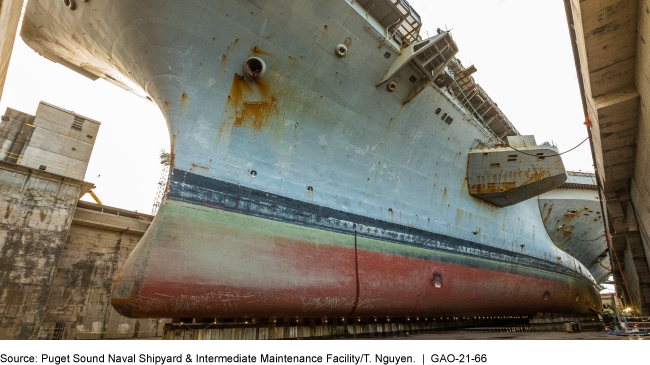Navy Maintenance: Navy Report Did Not Fully Address Causes of Delays or Results-Oriented Elements
Fast Facts
The Navy is working to rebuild readiness while modernizing its aging fleet of carriers, ships, and subs. While completing maintenance on time is essential to this effort, the Navy has generally been unable to do so.
A July 2020 Navy report identified some causes of maintenance delays, like insufficient shipyard capacity. But the Navy didn't consider delays caused in the acquisitions or operations phases, such as those caused by not setting effective maintenance requirements when it acquired ships.
We didn't make recommendations in this review, but we have made 39 unclassified recommendations on Navy maintenance since 2015.
Puget Sound Naval Shipyard & Intermediate Maintenance Facility

Highlights
What GAO Found
The Navy's July 2020 report identified two key causes and several contributing factors regarding maintenance delays for aircraft carriers, surface ships, and submarines, but did not identify other causes. For public shipyards, the Navy's report identified the key cause of maintenance delays as insufficient capacity relative to growing maintenance requirements. For private shipyards, the Navy's report identified the key cause as the addition of work requirements after a contract is awarded. These causes and other identified factors generally align with factors that GAO has previously identified as originating during the maintenance process. However, the Navy's report did not consider causes and factors originating in the acquisition process or as a result of operational decisions, as shown below.
GAO-Identified Factors Contributing to Maintenance Delays That the Navy Identified in Its July 2020 Report

The report identified stakeholders needed to implement action plans, but did not fully incorporate other elements of results-oriented management, including achievable goals, metrics to measure progress, and resources and risks. Some examples from the report:
- Stakeholders: Identified Naval Sea Systems Command as the primary implementer of most initiatives related to maintenance at shipyards.
- Goals: Included a goal of reducing days of maintenance delay by 80 percent during fiscal year 2020.The Navy did not achieve this goal based on GAO's analysis of Navy data.
- Metrics: Included some metrics. The Navy is still identifying and developing other key metrics.
- Resources: Did not identify costs of the actions in the report.
- Risks: Identified as risks the coronavirus pandemic, unstable funding, and limited material availability. However, the report did not assess additional risks that GAO previously identified.
Why GAO Did This Study
The Navy generally has been unable to complete ship and submarine maintenance on time, resulting in reduced time for training and operations, and additional costs. The Navy's ability to successfully maintain its ships is affected by numerous factors throughout a ship's life cycle, such as decisions made during acquisition, which occurs years before a ship arrives at a shipyard for maintenance. Others manifest during operational use of the ship or during the maintenance process.
The conference report accompanying a bill for the Fiscal Year 2020 Consolidated Appropriations Act directed the Secretary of the Navy to submit a report identifying the underlying causes of maintenance delays for aircraft carriers, surface ships, and submarines and to include elements of results-oriented management. The conference report also included a provision for GAO to review the Navy's report that was released in July 2020. This report evaluates the extent to which the Navy's report (1) identifies the underlying causes of maintenance delays and (2) incorporates elements of results-oriented management. GAO reviewed the Navy's report and interviewed Navy officials.
Recommendations
Since 2015, GAO has made 39 unclassified recommendations related to Navy maintenance delays. The Navy or the Department of Defense concurred or partially concurred with 37 recommendations, and had implemented six of them as of September 2020.
